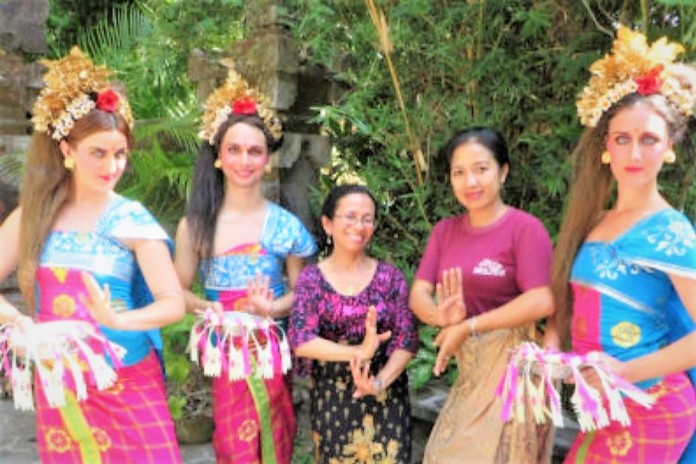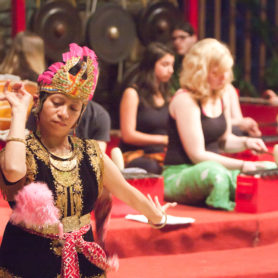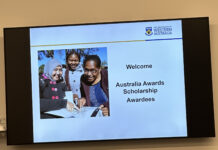
Cultures speak volumes about a nation’s origin and history. It is crucial to not only be proud of our cultures but also actually learn and have a deep understanding of the cultures we take pride in. Our columnist, Inef, interviewed Siti Kusujiarti, an Indonesian Professor at Warren Wilson College, a small liberal arts university in Swannanoa, North Carolina. Siti works as the head of sociology and anthropology departments and she has been teaching there since 2000. She has been promoting Indonesian cultures in several campuses in the US and through different activities for years. She also got involved in the university’s gamelan ensemble at Wilson College. In her free time, she performs classical Javanese dances too.
Besides her role as a department head, Siti is also serving as the chair of the ASIANetwork Board of Directors at Warren Wilson College. The network is an organization that promotes field studies to Asian countries and fund numerous faculty-student fellowships. Siti has led several study abroad trips to Indonesia in a program she named Monkey Chants and Ancient Dance—Art and Social Change in Bali and Java.
This program runs for three weeks at a time and there is at least one semester in which Siti’s students take a preparatory class to prevent any culture shock and to evaluate any misinformation they may have about Indonesia so that when they are ready to visit Indonesia they will be equipped with a knowledge of Indonesian politics, customs, and ways of living. Siti said that a few of her study abroad participants went on to secure internships for academic purposes in several universities across Indonesia.

Siti is also the author of “Power, Change, and Gender Relations in Rural Java: A Tale of Two Villages”, published by Ohio University in 2012. Her research about the role of feminism in post-tsunami Aceh has been published by the Bridgewater State University’s International Journal of Women’s Studies in Massachusetts. In this article, I am also bringing you Siti’s views on the meaning of identity, the most common misinformation foreigners have about Indonesia, how cultures change and evolve, and how to differentiate between cultural appreciation and cultural appropriation.
Siti graduated with a bachelor’s in Sociology from Universitas Gajah Mada and a master’s and a doctorate in the same field from the University of Kentucky. After graduation from the University of Kentucky, she went back to Indonesia for several years until she found a job at Ohio University as an adjunct professor. She left her job at Ohio University when she was accepted for a post-doctoral position at Western Carolina University. This job led her to her current role at Warren Wilson College. Siti said she chose to teach at a small liberal art university because it has a strong sense of community and she is happy there.

Siti is a Javanese woman from Jogjakarta, a mother, and a wife. When asked whether her identity as a Javanese is more important than her identity as an Indonesian or vice versa, Siti argued that identity is fluid and flexible, thus she can never say that one is more important than the other. Her identity can switch back and forth in some situations, depending on whether she is giving a lecture, performing in public, or out with her daughter. “Identity is very closely related to our status in our society and our relationships with the individuals in our life,” Siti explained. “It is a complex thing because it is comprised of our personal experiences and the expectations our societies have on us,” She added. As an example, Siti pointed out that even a person’s name has meaning. Her name, for instance, is unmistakably Indonesian. That is helpful to distinguish her among her colleagues and acquaintances because “not everyone knows where [Siti] is from, but [her name] prompts a conversation”.
During our discussion, Siti shed light on some misconceptions that foreigners and westerners, Americans in particular, have about Indonesia and why those misconceptions occur. “People who are not from Indonesia may misjudge our country simply because they lack factual information,” Siti stated. One of the many ways in which Siti has contributed to combating foreigners’ misconceptions of Indonesia is of course through education. “Most of my Americans students who went with me to a study away course to Indonesia often expressed an interest in returning to learn more about Indonesia,” Siti proudly said, “I have heard them telling their stories from mouth to mouth and this inspire their friends to learn our language. I even have several students who take an independent study class with me. In that course, I help them to have a deeper understanding of Southeast Asian nations,” Siti shared.

When asked about her opinion on what differentiates Indonesian cultures from the cultures of our neighboring countries or even the cultures of other countries in the Asian region, Siti started her explanation by first agreeing that each country does have interesting cultures. However, Siti also noted that each country has a distinctive demographic profile and population density, thus when she teaches her introductory classes on Indonesian politics and history, she always begins with the basic facts, such as that Indonesia is a big archipelago on the equatorial line with one of the highest number of Muslims in the world and that there are thousands of ethnic groups and tribes in Indonesia but everyone lives under the common banner of unity in diversity and one lingua franca, our national language Bahasa Indonesia.
From there, Siti can then introduce her students to the concept of “syncretic culture”, in which different cultures in Indonesia syncretize into the pluralistic society we see today. “Our ancestors were very creative and dynamic. For example, look at all the traditional foods we have, how rich our culinary tradition is!” Siti gave the example of croquettes, a popular snack, which has been adopted from a Dutch recipe, and thus the flavor is now uniquely Indonesian and does not taste like the croquettes in the Netherlands.
Siti said that as a rule of thumb, we can generally say we have appreciated a culture when we truly understand and have a good knowledge of the civilizations that produce the cultures we admire, for example when we truly know how Batik is created and when we wear Batik respectfully and not just as an accessory or a sign that we are well-traveled and cool. On the other hand, cultural appropriation happens when we wear something or take part in a culture other than our own without fully acknowledging how we selfishly take advantage of it while we may not yet understand the symbolism and implied meanings behind the culture.
In the end of our conversation, Siti would like to remind the readers that taking pride in our own culture is a good thing as long as that pride comes from a place of deep understanding, love of our birthrights, and respect.







